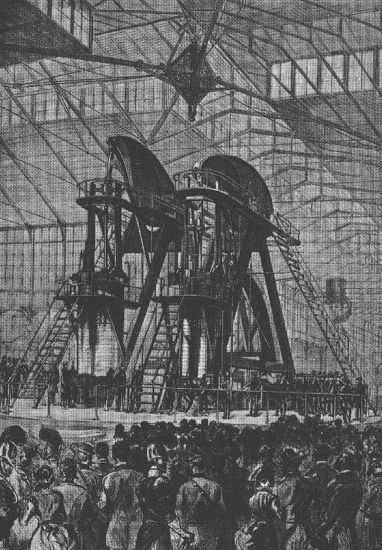Geek’s Corner: Monsters of Steam Power

All it takes is one mention of steam power and, being who I am, I naturally start thinking about the Corliss engine.
What. The Corliss engine. Don’t tell me you’ve never heard of the Corliss engine before. And you call yourself a nerd!
The Corliss engine, in its time, was the most awesome power-generating mechanism ever devised. Today a thing like a stationary engine is something that we, the children of the age of electricity, have a hard time getting our minds around. Even in many modern factories, the machines we use are simply connected to wall outlets. The energy they consume is generated somewhere else, tens or even hundreds of miles away.
But once upon a time in the industrial era there was no such thing as a power grid. If you wanted to run a state-of-the-art, oh…let’s say a textile mill, you needed machines. But to run those machines you needed power. That power didn’t travel down a wire back then, it had to be generated — on site.
Water wheels are an early example of the principle. Once they powered everything from grinding equipment to saws, metal rolling machines, wire drawing gear and weaving machines. But with the dawn of the industrial revolution more power was needed than falling streams could provide. More, er…oomph was needed.
In the 19th Century that oomph was supplied by steam engines. Fueled by wood or coal, steam engines were basically locomotives that didn’t move. Sure, the power they generated turned wheels, but those wheels were connected to an elaborate system of spinning gears and shafts that would carry to the power — in the form or torque — to all the various machines in the factory. The more machines you had, the more power you needed and the bigger your engine needed to be.
Corliss engines pretty much filled that bill. Early versions of the Corliss engine from the mid-1800’s were horizontal, about 20 feet long and driven by a single steam-powered piston. The later, bigger versions were vertical. They had up to four pistons that drove fly wheels that weighed over 50 tons, and were over 70 feet tall. The slowly turning wheels generated up to 1,400 horsepower which is, you know, a lot. No wonder some of these things weren’t finally retired until the 1990’s.
The unveiling of the 1876 Centennial Engine at the World’s Fair in Philadelphia was a literal earth-shaking event. The engine was the biggest and most powerful that had yet been made. Via a system of underground shafts, it supplied all the energy for the fair that year.
The 1893 engine, built for the Columbian Exposition in Chicago, was even bigger. But this time, instead of driving a system of mechanical doodads, the engine drove an electric dynamo. When connected to Nikola Tesla’s revolutionary alternating current system, the giant engine created enough electricity to supply all the fair’s newfangled electrical appliances with energy to spare. In fact that “spare” energy was enough to light the 200,000+ lightbulbs that glittered at night (they were also state-of-the-art technology at the time).
What the heck does all this have to do with baking? Three words: I. Don’t. Know. But isn’t there something exciting in the idea that the same force that drove the Corliss engine is the one you’re using to push up your filo dough? I dunno…maybe it’s just me.
Thanks for a very interesting post. But are you sure that modern power outlets supply energy that is “generated somewhere else, tens or even hundreds of miles away?” I’m pretty sure the outlets in my own house get their electricity from the fuse box in my garage. Isn’t that what we mean by “fusion?” Or is that something else?
I’m the only wise-ass on this virtual corner, bub. Smarty pants comments like this must be submitted in triplicate to the attendant at your nearest Joe Pastry regional office. Thank you.
This is what I get for trying to be thorough. Sheesh!
– J
As a scholar of the 1876 Centennial I applaud your appreciation of the Corliss Engine. It really was a remarkable device. What that has to do with baking, IDK, either…
If you’re ever in Eastern Pennsylvania around the 4th of July, check out the Kutztown Folk Festival. While it is mostly about vendors selling things, they have a large number of exhibits about the Pennsylvania Dutch and their technology. They have a steam-powered tractor they run around the fair once a day. A mobile version of your engine! They also always have an impressive number of “putt-putt” two-stroke engines, but I love the variety of farm implements powered by the fly wheel on the tractor – just run a belt around the flywheel to whatever you need to power. And to tie it into baking; apple dumplings, shoe-fly pie, corn fritters…
Bingo! That’s exactly what those power sources were used for. I’ll be sure to visit if/when the opportunity comes up, Ann! Thanks very much for the note!
– Joe